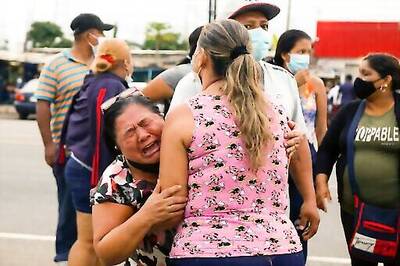
views
HONOLULU: Hawaii officials are facing pressure to increase COVID-19 testing for travelers as the islands weather a record surge and federal guidelines change to require negative virus tests from both vaccinated and unvaccinated people coming to the U.S.
State leaders have resisted implementation of a two-test policy for arriving travelers, despite evidence that more COVID-19 testing would help reduce the spread of disease, especially in an isolated destination like Hawaii.
Earlier this summer, the state removed all testing requirements for vaccinated people.
And even with a single pre-flight test for unvaccinated travelers, experts say infected passengers can easily slip through the cracks.
Because of the incubation and latency periods of COVID-19, using just one test to prevent spread among tens of thousands of daily visitors is akin to using a chain link fence to keep out mosquitos, said Dr. Darragh OCarroll, an emergency and disaster physician in Honolulu.
There are a lot of holes,” O’Carroll said. The science has been fairly conclusive since probably June of 2020 that a single test system was no more effective than 30 to 40% in catching a population of infected people.
New federal rules announced Monday require all foreign travelers flying to the U.S. to demonstrate proof of vaccination before boarding, as well as proof of a negative COVID-19 test. Unvaccinated American citizens will need to be tested within a day before returning to the U.S., as well as after they arrive home.
O’Carroll and a number of his colleagues have been pushing state leaders to do the same, he said.
Nobody really seemed to listen,” he said. “No matter what we said and how conclusive the science looked.
After months of mandatory quarantines, business closures and virtually no tourists, Hawaii had among the lowest infection rates in the nation. Then, in October 2020, the state allowed travelers to skip quarantine with a single pre-flight test.
Infection rates increased, but they remained low compared to other states. Some of that has been attributed to a severely crippled tourism industry and a lack of participation in leisure travel. And some believe visitors do not see the incentive to test after arrival when facing quarantine away from home.
But when travel numbers increased this summer, so too did infection rates.
In July, Hawaii lifted its quarantine and testing requirements for vaccinated travelers. A month later the state was in the throws of a record surge of delta variant cases that were filling hospitals and leaving more people dead than at any other time in the pandemic.
Before July, Hawaii reported a seven-day average of 46 daily cases. In the first week of September, that number was up to nearly 900. Case rates have slowly begun to decline since, but experts say it’s unclear if that will hold.
Much of that was community spread fueled by the delta variant which was introduced through travel.
Scientists say implementing additional testing measures could help.
A study published in March in the medical journal The Lancet Infectious Diseases showed that the risk to an overall population is reduced by only 36% through a single pre-flight test. But a two test system coupled with a short quarantine period catches a much higher rate, in excess of 70% of infected travelers, according to the study.
Lee Altenberg, an adjunct full professor in the mathematics department at the University of Hawaii, wrote that the paper is one of very few studies available to inform policy makers in Hawaii.
But, he said, the research was mischaracterized as proof that Hawaii’s single test system was highly effective at preventing spread. State officials said the study proved their single test system would catch 88% of all infected travelers.
The public had the wrong impression about how much protection we were getting from the Safe Travels pretest program, and you cant make good policy if you dont have accurate information, Altenberg said.
We need to get absolutely serious about our travel protocols, Altenberg added. And if were laboring under the misimpression that (Safe Travels) is preventing 90% of infections, were not going to get serious about those protocols.
The authors of the study said that the 88% figure represents the percentage of contagious people that would be detected on the day of travel, not the overall reduction of risk to a destination population.
The difference between infected and infectious is important, said one of the study’s co-authors.
There obviously are people that … will develop an infection but are not yet infectious, said Dr. Nathan Lo, faculty fellow in infectious diseases at the University of California, San Francisco and co-author of the study. And those people will not be detected necessarily.
Gov. David Ige did not respond to an interview request, but the state did announce Monday that 1 million free rapid tests are being provided for routine testing of Oahu residents.
Lt. Gov. Josh Green told The Associated Press that decisions about testing are ultimately up to the governor, but noted that Hawaiis single test policy is more than other states in the U.S. have done, helping keep the islands safe.
If the mayors want to do additional testing, I absolutely support that,” Green said. “Offering voluntary take-home antigen tests upon arrival for vaccinated and unvaccinated travelers could offer additional protection given the delta variants highly infectious nature.
But Green said the single test system is more than any other state, except for Alaska, has done in terms of travel testing. Alaska is also dealing with a record surge of COVID-19 that has crippled the states health care system.
“Weve done more than everyone else, weve done a better job than everyone else, Green said.
Dr. Mathew Kiang, an epidemiologist and professor at Stanford University, was the lead author on the Lancet study. He worries about the lack of routine travel testing as well as so-called breakthrough infections for those who are vaccinated. Experts say the shots help reduce the severity of the illness, but people who get infected could spread it to others.
Theres a lot we still arent quite sure about for … breakthrough infections, especially in terms of asymptomatic spread,” Kiang said. But “we know delta is one of many variants of concern and this is going to keep evolving over time.
Kiang said additional testing allows you to bring in more visitors and it allows you to ramp up the economy.”
Disclaimer: This post has been auto-published from an agency feed without any modifications to the text and has not been reviewed by an editor
Read all the Latest News , Breaking News and Ukraine-Russia War Live Updates here.




















Comments
0 comment